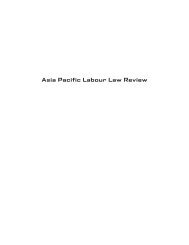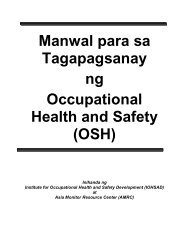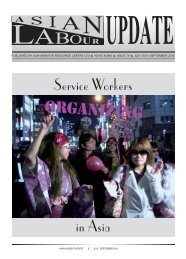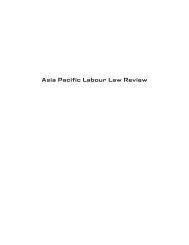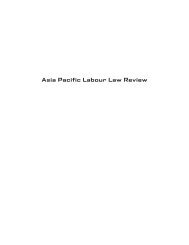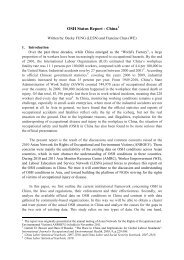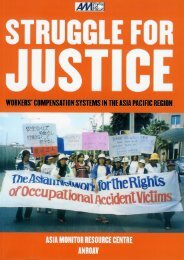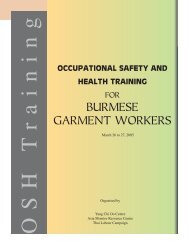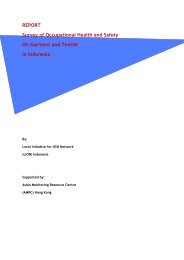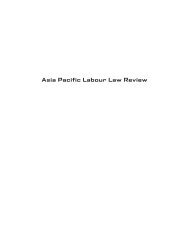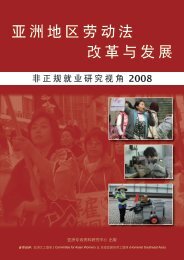Nepal - Asia Monitor Resource Center
Nepal - Asia Monitor Resource Center
Nepal - Asia Monitor Resource Center
Create successful ePaper yourself
Turn your PDF publications into a flip-book with our unique Google optimized e-Paper software.
<strong>Asia</strong> Pacific Labour Law Review
<strong>Asia</strong> Pacific Labour Law ReviewWorkers’ Rightsfor the New Century<strong>Asia</strong> <strong>Monitor</strong> <strong>Resource</strong> Centre2003
<strong>Asia</strong> <strong>Monitor</strong> <strong>Resource</strong> Centre Ltd.AMRC is an independent non-governmental organisationthat focuses on <strong>Asia</strong>n and Pacific labour concerns.The <strong>Center</strong> provides information, research, publishing, training, labour networkingand related services to trade unions, pro-labour groups, and other development NGOs.AMRC’s main goal is to support democratic and independent labour movements in <strong>Asia</strong> and the Pacific.In order to achieve this goal, AMRC upholds the principlesof workers’ empowerment and gender consciousness, and follows a participatory framework.Published by<strong>Asia</strong> <strong>Monitor</strong> <strong>Resource</strong> Centre Ltd (AMRC), 444 Nathan Road, 8-B, Kowloon, Hong Kong, China SARTel: (852) 2332 1346 Fax: (852) 2385 5319 E-mail: admin@amrc.org.hk URL: www.amrc.org.hkCopyright © <strong>Asia</strong> <strong>Monitor</strong> <strong>Resource</strong> Centre Ltd, 2003ISBN 962-7145-18-1All rights reserved. No part of this publication may be reproduced, stored in a retrieval system, or transmittedin any form without prior written permission.Editorial TeamStephen Frost, Omana George, and Ed ShepherdLayoutTom FentonCover DesignEugene KuoAcknowledgementsAMRC expresses sincere thanks to the following people and organisations for their gratefully receivedcontributions to this book.Suchada Boonchoo (Pun) is co-ordinator for the <strong>Asia</strong>n Network for the Rights of Occupational AccidentVictims. We thank her for all the help in organising our conference of authors in Bangkok.Thanks to the American <strong>Center</strong> for International Labor Solidarity, Bangkok, Thailand for a financial contributiontowards printing the book.We are indebted to Oxfam Hong Kong for their financial contribution towards the production costs.Thanks to the International Labour Organisation for allowing us to use photographs from their library freeof charge.Eugene Kuo, a freelance photographer and designer, a big thank you for contributing photographs and designingthe cover free of charge. Look at www.226-design.com for some of Eugene’s stunning work andideas.To Tom Fenton, co-founder (with Mary Heffron) of AMRC – thanks a lot for advice, maps, and all the timedevoted to the layout of the book, free of charge. E-mail: tfenton@igc.org.Finally, we would like to thank the International Centre for Human Rights and Democratic Development,Canada, for an extremely generous contribution that covered much of the publishing costs of this book.Without their last-minute financial assistance, it is possible that this book would never have proceeded beyondthe editing stage. E-mail: ichrdd@ichrdd.ca; URL: www.ichrdd.ca.<strong>Asia</strong> <strong>Monitor</strong> <strong>Resource</strong> Centre
Labour Law and Practices in <strong>Nepal</strong>By Gopal Siwakoti ‘Chintan’Introduction<strong>Nepal</strong> was cut off from the mainstream of societal development for centuries due to its diverse geographicalmake-up. The country was divided into small kingdoms until the latter half of the 18th century, when it was unifiedby Prithvi Narayan Shah of Gorkha to become the Kingdom of <strong>Nepal</strong>.Due to <strong>Nepal</strong>’s chaotic political development in the first half of the 19th century, the economic needs of thepeople were ignored. The people began to break away from complete dependence on agriculture and traditionalways of economic livelihood only in the twentieth century.During the Rana period, little attention was paid to the systematic development of the country’s resources. Thepalace-led revolution of 1950-1951 and the subsequent overthrow of the Rana regime marked the beginning of<strong>Nepal</strong>’s emergence into the modern world, but its economy was still rooted in the medieval past (Karan and Ishii1996). 11
South <strong>Asia</strong>took place from 1990 to 1999. The duration of the labourstrikes ranged from one day to 220 days. During this decade,GEFONT alone filed 179 cases in the LabourCourt. Among these cases, the Court gave verdicts in favourin 46 percent of the cases and 12 percent against. 18percent of the Court cases are still pending and 24 percentare in the process of legal settlement. The trend ofindividual demands is on the decline. It has been foundthat the enterprises executing the Regulations are 33 percent,those executing the Trade Union Act are 36 percent,and those following the Court verdicts are 12percent. This indicates that the achievements madethrough collective bargaining and/or from Court settlementare encouraging.LegislationFollowing the establishment of some industries in themid-1930s, there has been some consideration about industrialand labour policy. Due to adverse effects of labourlaw and the absence of adequate benefits, a majorstrike took place in 1947 in Biratnager Jute Mill. Thisstrike is considered as the beginning of the labour movement.However, <strong>Nepal</strong> did not have any labour laws definingrights and responsibilities, except a fewprovisions in Muluki Ain (National Code), until 1959.Trade unions have done much to protect the rights ofthe workers, but this is only apparent in formal sectors.With respect to informal sectors, there is still much to bedone to safeguard workers’ rights and guarantee minimumwelfare. The trade unions have formed forums forthe emancipation of agricultural labourers. They havebeen continuously raising their voices to end the exploitationin the field of contract labour. They take initiativesto prevent and control the practice and the exploitationof child labourers. On social security issues, they arebuilding up new platforms to pressurise the governmentfor their rights to social security. They are also engagedin advocacy against the discrimination of womenlabourers.In 1959, the <strong>Nepal</strong> Factory and Factory Workers Actwere introduced followed by the adoption of labour regulationsin 1962. These provisions addressed issues likeworkers’ safety, working hours, working conditions,employment conditions of women and children, minimumwage, gratuity, compensation for injuries, paidleave and public holidays, as well as social security andsocial welfare-related measures (Karki 2000, p. 41).In 1972 the Bonus Act was introduced but it was onlyapplicable to the formal manufacturing sector. Workersengaged on tea estates, agriculture, and other unorganisedsectors were not covered under this law. It was onlyafter the restoration of the multi-party system in <strong>Nepal</strong> in1990 that a new era of industrial activities began and labourlaws were strengthened and introduced in a morecomprehensive manner. Labour became one of the mainissues on the agendas of all the emerging political partiesand governments. <strong>Nepal</strong> also began to ratify various internationaltreaties of the United Nations and InternationalLabour Organisation guaranteeing labour andwelfare rights. The combination of domestic constitutionaland legal provisions as well as the internationaltreaty obligations has dramatically changed the status oflabourers in <strong>Nepal</strong>, regarding labour administration,participation in trade union activities, tripartite consultations,and administrative and judicial measures againstunfair labour practices.Article 26(6) of the 1990 Constitution of the Kingdomof <strong>Nepal</strong> provided that ‘the State shall peruse a policyof increasing the participation of the labour force, thechief socio-economic force of the country, in the managementof enterprises by gradually securing employmentopportunities to it, ensuring the right to work, andthus protecting its rights and interests’.The only problem with this policy is that it is not enforceableby any court of law unless it is translated into alaw. However, the Supreme Court, in different judgements,has declared that it is the fundamental responsibilityof the government to adopt necessary lawstowards the implementation of directive principles andpolicies of the state in a gradual manner, but not to violatethem in any circumstances.Labour rights provisionsFor the first time, in the history of <strong>Nepal</strong>, article 20 of the1990 Constitution has provided for fundamental rightsagainst exploitation of labour and child workers. Underthe Constitution ‘traffic in human beings, slavery, serfdom,or forced labour in any form is prohibited’ and ‘nominor shall be employed to work in any factory or mine,or be engaged in any other hazardous work’. The violationof any of these provisions is punishable by law.6<strong>Asia</strong> <strong>Monitor</strong> <strong>Resource</strong> Centre
NEPALCivil Rights Act 1955The Act, the first labour legislation in <strong>Nepal</strong>, providesvarious rights of the citizens under one law. It alsohas specific provisions relating to labour rights. Section13 of the Act ‘prohibits anyone to engage a person in anywork against his will except in accordance with law’.Likewise, under Section 14, it also imposes restrictionupon ‘anyone to employ a minor below 14 years of ageas a labourer in a factory or mine or in any hazardouswork’. In case of violation of these provisions, a civillaw suit can be brought before the Appellate Court andrelief sought by asking for an order of injunction againstthe perpetrators or compensation to the victims.Muluki Ain 1962The chapter on Wage (Jyala Majuriko) in Muluki Ain1962 prohibits forced and free labour without the consentof the labourer. It provides that there must be an arrangementfor wages to be paid or remuneration throughmutual agreement between the employers and the employeesconcerned. In the absence of any such agreement,the prevailing local rate of wage/remuneration isto be made applicable. Furthermore, the workers are alsoprohibited from leaving the work incomplete. It laysdown fines at different rates against those who are engagedin the practice of forced labour and those who donot pay fair wages. Those who leave work before completionare required to pay money for the loss incurred.However, such fines and compensation can only be obtainedthrough proper legal action. This general provisionof Muluki Ain also coincides with the generalprovisions of the Contract Act, 1967 that governs contractualrelations between the employers and workersengaged in non-formal or informal sectors.Labour Act 1992The Labour Act 1992 is <strong>Nepal</strong>’s most comprehensivelabour law to date. It was the prerequisite for the subsequentadoption of Labour Regulations 1993, Tea EstateRegulations 1993, and Labour Court (Procedures) Regulations1995. The main provisions of these laws andregulations is summarised below:i) Employment and Security of ServicesThe Act mainly focuses on job security of workersand employees. It provides for the compulsory letter ofappointment once he or she is selected through an openand public competition process. A permanent letter ofappointment is to be issued upon the completion of aone-year probation period. The letter of appointment includesall the terms and conditions of the job, amount ofremuneration, and other benefits. A contracted workerautomatically receives permanent status upon providingservice for 240 days.The Act prohibits the employment of child labourersin any enterprise. A minor above the age of 14 and a femalewith proper security and safety arrangements maybe allowed to work at anytime. However, a minor belowthe age of 16 must not be employed to work for morethan six hours a day and 36 hours a week. The Act alsoprovides for job security.The Act also bars employers from firing permanentworkers unless it is done in accordance with the law.Similarly, employers are prohibited from cutting thenumber of labourers without permission from the government.When doing so, employers must provide sufficientreasons for such measures, e.g. the closure of theenterprise for more than three months under specialcircumstances.ii) Working HoursThe working hours are fixed at eight hours a day or 48hours a week with a one-day weekend holiday. Workersare also eligible for half an hour break for refreshmentevery five hours. In case of overtime, they are to be paidat the rate of one and a half times more than their regularwage.iii) RemunerationEvery worker must be paid a minimum wage as prescribedin the letter of appointment. Such allowance andrelated facilities may vary in different geographical regions.A permanent worker is entitled to receive an annualgrade and salary-increase. Payments may be madeon a weekly, fortnightly, or monthly basis except in thecase of a daily wage contract. The employers are alsoprohibited from reducing the fixed wage, unless the lawauthorises it. Complaints can be made before the LabourOffice in case of violations of these provisions within sixmonths of the date of the violation. In the case of falsityof the allegation, the employees will be required to payup to Rs 1,000 (US$14). In the case of the loss of a jobfor some legally valid reason, the employees areawarded compensation and they cannot take the case tocourt. It is considered a mutual agreement.<strong>Asia</strong> Pacific Labour Law Review7
South <strong>Asia</strong>iv) Health and safetyThe Act has made provisions for the health, safety,and welfare of workers and employees. They includeregular cleaning of the workplace, proper facilities forsewage, supply of drinking and washing water, fresh air,proper lighting system, appropriate temperature, adequateworking space, pollution-free working atmosphere,separate toilets for men and women, no-smokingzones, and compulsory health check-ups on an annualbasis. Proper arrangements for the safety of eyes, protectionfrom chemical substances, and safety measuresagainst fire and guards on hazardous machines, are specifiedin the Act. There are also limits for lifting heavyweights and working in hazardous plants.v) Welfare provisionsAn enterprise is required to create a welfare fund forits workers, which can be used to provide compensationfor the families of the diseased and for the workerswounded during work. There is also a provision for gratuity,a provident fund, and medical care under the LabourRegulation 1993. It also describes provisionsrelating to government holidays, special leave, and paidor unpaid leave, includes recommendations for quarters,leisure rooms, canteens, and childcare facilities. However,the absence of a welfare system as well as the lackof effective implementation of enterprise-based welfarebenefits always makes the life of the workers and theirfamilies difficult and vulnerable.Specific provisions under labour lawfor sectoral enterprisesThe Labour Act 1992 has made specific provisionsfor some industrial sectors. For example, the governmenthas assumed the authority of constituting a committeeto render necessary advice on promotion, policyformation, and other related matters in respect to the teaestates. In construction businesses, the employers are requiredto supply construction tools, provide labour quarters,food, drinking water, accident insurance, andadequate safety arrangements at construction sites.Similarly, in the transportation sector, on a long routepublic bus service, the employers must have a provisionfor two drivers for alternate driving. Likewise, a drivertransporting animals and goods is to be allowed frequentrest. They should be paid for overtime after eight hoursof work at the rate of one and half times the normal salaryor a trip allowance, food allowance, or any other allowance,whichever is higher and more beneficial. Theworkers are also eligible for adequate compensation incase of the termination of their jobs due to the transfer ofownership. In the hotel, travel, trekking, adventure, rafting,jungle, and safari businesses, there has to be specialarrangements for the employment of female workers, fortheir proper safety and security, depending on the natureof work.The employer is authorised to punish any employeeon the grounds of misdemeanour. The measures of suchpunishment include reprimand, effects on annual gradeincrements, suspension, and discharge from service dependingon the nature and the seriousness of the offence.The employee has a right to respond to the action taken.In the case of the misuse of authority or violation of thelaw by the employers or managers, the Department ofLabour can take action against them and quash any illegaldecisions made by them.The Act has provided procedures on personal claimsand complaints against the employer relating to service.In case of such claims and complaints, the employer hasa duty to settle the matter within 15 days. The Act hasalso laid down procedures in case of claims of collectivedisputes that arise out of collective interests or rights etc.Such a claim must be signed by at least 51 percent of theworkers/employees of the enterprise and be submitted tothe employer for settlement through a bilateral agreement.The Labour Office plays an administrative role insettling the disputes. The Act renders the legal stamp tothe collective agreement and makes it legally binding forboth the parties. Such agreements have to be registeredat the Labour Office. The government is also empoweredto constitute a committee to finally settle any outstandingor possible labour disputes. Hence, thegovernment is conferred immense power by the LabourAct to settle industrial disputes. The government, uponconsultation with the Central Labour Advisory Board,may exempt any enterprise from application of any provisionof this Act for a specific period of time. It can alsoprescribe minimum remuneration and certain privilegesin accordance with the provisions in the Act where lessthan 10 employees are engaged.The Act has made special provision with regards tonon-enterprise workers. Accordingly, the payment of remunerationfor work has to be made by the employer in8<strong>Asia</strong> <strong>Monitor</strong> <strong>Resource</strong> Centre
NEPALaccordance with the contract agreement, if it exists. Inthe absence of such an agreement, payment has to bemade within seven days of the date of work performed.In the case of non-payment, the District Labour Officer,or in her/his absence the Chief District Officer, is authorisedto ensure such payment upon the request of the aggravatedparties.Labour court and disputesettlement processThe Labour Court is required to adopt its own rules ofprocedure as laid down under the Summary Trial ProceedingAct 1960. The Labour Court Regulation 1996governs other procedural aspects of the Court. The jurisdictionof the Court covers only rights-related disputesor grievance disputes but not interest-related disputes ordisputes of an economic nature which are not providedin the labour law. Thereupon, the Labour Office repeatsthe same procedure as above in settling the disputes. Thefailure of the settlement will invite the Chief Officer ofthe Labour Office to decide the matter within seven daysfrom the date of reference. An appeal against the decisioncan be filed with the Labour Court within 35 days ofthe notice of the decision. The dispute could also be settledthrough bilateral negotiation in the presence of a LabourOfficer. If this process fails then the case may bereferred to the mediator appointed with mutual consentof both the parties. If such a mediator is not agreed uponthen a tripartite committee are formed with the agreementof the parties, having equal representation of employersand employees as well as the government. Suchmediators or committees must make a decision on a casewithin 15 days. An appeal against the decision may befiled before the government within 35 days of the noticeof the decision. If the government does not decide thematter within 60 days from the date of appeal then theworkers may put pressure on the management by stagingpre-informed strikes. The employer may declare a lockout with the approval of the government as a last resortto settle the dispute collectively. Strikes are prohibitedin certain enterprises, e.g. security institutions and dailypublic utilities. The same demands cannot be raised foranother two years after the date of the settlement of thedispute. The government is empowered to call off anystrike and end a lockout at any time in extraordinarysituations.Gender-related labour lawsAccording to the law, women have the equal right towork in any enterprise. They are also eligible for extrabenefits than their male-counterparts. An employer isnot allowed to employ a female worker at night. She isalso allowed to give proper care to her child and takenecessary breaks for breast-feeding. There is also a provisionfor day care centres in the workplace.Nevertheless, existing law and policies do not addressthe issue of gender equality in the employmentsector. To incorporate gender equality issues in all sectorsof work, the Federation of <strong>Nepal</strong>ese Chambers ofCommerce (FNCCI), and the representatives of theDemocratic Confederation of <strong>Nepal</strong>ese Trade Unions(DECONT), GEFONT, and the NTUC signed an agreementon 27 November 2002 to start a process of socialdialogue. The same has already been highlighted in thePoverty Reduction Strategy Paper in April 2002 that advocates‘Decent Work for Poverty Reduction’. To givefinal shape to this initiative, the Ministry of Labour, theFNCCI, and the three major federations have furtheragreed to establish a joint sub-committee on PromotingGender Equality in the World of Work within the frameworkof the Central Labour Advisory Committee. Itsmain objective is to review and promote measures toachieve gender equality at work. These three federationsalso have set up a Trade Union Committee for GenderEquality and Promotion to ensure follow-up and effectiveimplementation.Common gender issues in the workplace:• Maternity protection;• Employment opportunity, security, and training;• Working conditions;• Equal remuneration and other benefits;• Leave;• Law against sexual harassment and violence;• Occupational safety and health;• Information on HIV/AIDS;• Ratification of ILO Conventions Nos. 89, 183,155, and 156;• Formation of unions in informal sectors.Trade Union Act and the Regulation 1992Trade unions are the by-product of the multi-partysystem in <strong>Nepal</strong>. Article 12(2)(c) and (e) of the Constitutionalso provide for a framework, guidelines, and re-<strong>Asia</strong> Pacific Labour Law Review9
South <strong>Asia</strong>strictions relating to the formation of any organisation,union, or association.The underlying objective of the Act is to make a provisionfor the registration and operation of trade unionorganisations, as well as to guarantee the rights and welfareof workers, whether they are permanent, temporary,or contract. Workers of any enterprise having at least 25workers may form an enterprise-level trade union.Similarly a 50-member workforce may form an enterprise-leveltrade union. A 5,000-member workforce,composed of various enterprises of a similar nature, orat least a 250-member workforce, working outside anenterprise but engaged in various businesses and professionsof a similar nature, may form a trade union.At least 10 trade unions, through agreements, mayform a greater trade union association or a federation,but no one can be a member of more than one association.This Act has a provision for Authorised TradeUnions, by which the problem of multiplicity of tradeunions is partially resolved. However, the law providesthat no union can be formed in a newly establishedcompany until after an initial one year period,and it also requires employees to have worked theminimum service of 240 days to be elected to the unionleadership.Bonus Act 1971 and Bonus Regulation 1981The labour law combines the Bonus Act 1971 and theBonus Regulation 1981. The bonus law is aimed to managethe distribution of bonus to the workers in privatesector enterprises. Each profit making enterprise is requiredto allocate 10 percent of its annual net incomefor distribution to its workers. Such enterprises are alsorequired to submit annual balance sheets and incomeand expenditure reports to the Labour Office for the ascertainmentof their income status. The bonus must bepaid in cash every year, or in certain cases, it can bepaid the following year, accumulated from both theyears. 50 percent of the bonus can be paid in advance incertain circumstances. No bonus is paid for any periodof absence from work, unless the period for absence isan exempted one, and no bonus is paid for any period ofillegal strikes. From the total amount in surplus afterpaying the bonus, 70 percent is to be deposited in thewelfare fund created under the Labour Act, and the remaining30 percent is to be deposited in the nationalwelfare fund created by the government. The settlementof any bonus dispute between the employers and employeeshas to be done by the Labour Office. These casescan also be produced before the Labour Court for finalsettlement. The Bonus Act has made penal provisionsagainst any violation of this law. It has been widely feltthat there is need to increase the share of bonus forworkers.Industrial Trainees Training Act 1982This Act was introduced to strengthen the professionalskills of the workers. Its main objective is tomaximise the engagement of workers for skills development.Such training may be provided by those enterprisesas prescribed by the government. 7Privatisation Act 1994After the adoption of the policy of economicliberalisation, privatisation has intensified. Although theprivatisation of public corporations is still a controversialissue in <strong>Nepal</strong>, enactment of the Privatisation Acthas resolved some of the issues of doubt. The law hasgiven first priority to the sale of shares to the workersand then to private parties during privatisation. Whileselling the shares, it is mandatory for the government toreview the economic status and the nature of the enterprise,and to increase the participation of workers as wellas the general public.At the time of transfer of ownership duringprivatisation, the government has a legal duty to ensurethe continuation of the same services and benefits, e.g.remuneration and gratuity for the workers. If the continuityof the service cannot be maintained such employeeshave to be retrenched with reasonable compensation.Despite failure of the privatisation of some public corporations,both in economic and social terms, other corporationsare still in the process of privatisation withoutlearning lessons from the past. During the process ofprivatisation in the past, the public enterprises were undervaluedby 29.28 percent leading to the loss of Rs. 250million. Furthermore, a total amount of Rs. 162 millionhas yet to be collected from the buyers, out of which 50percent is in interest and fines. Up to now, the governmenthas acquired Rs. 721 million from the privatisationof 16 enterprises, but 51 percent of this amount has beenspent on the process itself. (Proceedings 1999).10<strong>Asia</strong> <strong>Monitor</strong> <strong>Resource</strong> Centre
NEPALInternational instruments on labourstandards (See Appendix 3)<strong>Nepal</strong> has become a party to several International LabourOrganisation (ILO) conventions. This includesonly two of the core ILO conventions, (ILO ConventionNos. 111 on discrimination and No. 138 on child labour).<strong>Nepal</strong> has also ratified Convention Nos. 87 and 98on the right to organise free trade unions and the right tocollective bargaining. <strong>Nepal</strong>’s ratification of several ofthe United Nations human rights instruments, includingtwo covenants, the Convention on the Elimination of AllForms of Discrimination against Women and the Conventionon the Rights of the Child, which provide someguarantees on the rights and interests of the workers.However, the practical side of the compliance with theseinternational treaty obligations has been a major subjectof concern and criticism in the past decade.Nevertheless, <strong>Nepal</strong>’s existing labour law could beconsidered close to these international standards, but themain problem is in effective enforcement. The internationalcommunity is also responsible on the larger scalefor poor working conditions and the exploitation ofworkers. For example, the policies of the World Bank,IMF, and the <strong>Asia</strong>n Development Bank are more andmore labour-unfriendly. The donor countries and thetransnational corporations are not complying with humanrights and labour standards that they are committedto, both at home and before international forums. Thepractice of double standards is something that they needto abolish in order to assist the government and businessenterprises operating in <strong>Nepal</strong> to be more humane, transparent,and welfare-oriented.Labour law in a new perspectiveThe history of labour law in <strong>Nepal</strong> is very short. Therefore,it still needs to address many of the issues and problemsthat the workers face, particularly those engaged ininformal sectors and in rural areas. More recently, labourlaws have been formulated and enacted, howeverexisting laws mainly address the organised sectors.Moreover, poor labour administration and inefficientgovernment mechanisms are other problems that the laboursectors face. Even the Minimum Wage FixationCommittee has not been as effective as possible. The traditionalwage system is still in practice in remote areas.There are also serious problems in enforcing the collectiveagreements and the decisions of the courts or othergovernment bodies. <strong>Nepal</strong> needs to develop highly systematic,concrete and dynamic labour policy and laws toaddress the existing as well as future problems. To dothis, <strong>Nepal</strong> needs to review the labour policy and law inline with international human rights and labour rightsstandards and obligations and make them more comprehensive,specific, and functional.Due to the increasing global demands of liberalisation,the interests of the employment securities areheavily endangered. The working class population is increasing.There is no guarantee of job security. Manyeconomic and trade sectors are being informalisedthrough subcontracting work and labour to further avoidlegal and administrative monitoring of labour practices.A heavy burden is imposed on the workers in the nameof gaining competitiveness, cost minimisation and comparativeadvantage in international trade. It is quite unfortunatethat the government is facilitating this processof marketisation and the exploitation of the labour force,instead of playing their role as guardians. The carpet andgarment industries, the major export sectors, are some ofthe worst examples of such prevailing scenarios.The existing labour law does not address the actualsocial welfare and benefit of workers other than the provisionsof some traditional labour rights. The only socialsecurity in <strong>Nepal</strong> is the provision of Rs. 100 (US$ 1.5)per month to citizens above the age of 75 and widowsover 65.At a non-governmental level, GEFONT has startedan emergency fund. Similarly, the Independent TransportWorkers Union of <strong>Nepal</strong> is also operating an accidentfund for its members.Critical observation ofgovernmental measuresLooking at the existing labour laws and policy of thecountry, particularly the Labour Act and Regulations of1992 as well as the Trade Union Act of 1993, they havebeen criticised for not being comprehensive and progressiveenough to address the current needs and problems.The over-politicisation of trade unions both by thegovernment and the political parties has also been the issueof serious concern. In the case of the classificationand the fixation of the minimum wage, there has been no<strong>Asia</strong> Pacific Labour Law Review11
South <strong>Asia</strong>Notes1. Karan, P, P. and Ishii, H., eds., ‘<strong>Nepal</strong>: a HimalayanKingdom in Transition’, (1996 , p. 205- 227).2. Proceedings of High Level Panel Discussion onContemporary Trade Union Issues, GFONT/FES, 1999,p. 12-49.3. CWIN Annual Report, 2002. p. 14-38.4. Sharma, G. N., Uprety, H., and Dahal D. R., eds.‘Debt Trap and its Management in <strong>Nepal</strong>’, (NEFAS/FES, 1998).5. Shramic Khabar, Bhadra 1991, p. 6-12.6. Rimal. B., Trade Union Rights, 2001.7. <strong>Nepal</strong> Labour Journal, (GEFONT, August 2001,Shramik Khabar, no. 64, 65, 69, 70 [2058]).14<strong>Asia</strong> <strong>Monitor</strong> <strong>Resource</strong> Centre
NEPALAppendix 1Chronology of Major Events in 2000–2002 in the Labour SectorThousands of workers are being laid-off from stateownedcorporations due to the government’s economicreform measures. Many factories have declared bankruptcywithout paying workers’ wages, allowances, lay--off payments, or pensions. Public protests and sectoraldemonstrations have become routine for the workers allover <strong>Nepal</strong> and are on the increase. The situation hasgone from bad to worse due to the rapid privatisation ofpublic corporations free-market policies, the collapse ofindustries and enterprises due to unfair competition, andthe lack of anti-dumping policies at bilateral and multilaterallevels. <strong>Nepal</strong>’s eagerness to join the World TradeOrganisation and the South <strong>Asia</strong>n Free Trade Agreementis also making the situation more disastrous. Theseissues have become the subjects of primary concerns notonly for trade unions and their members but also for concernedcitizens and their groups.The scale of such increasing unrest in the labour sectorcan be observed from the following documentationof some of the events that have taken place since 2000.January 2000 - Workshop on Migrant Workers,GEFONT, New Delhi, India.Minimum wage fixed for agricultural workers.February 2000 - The enactment of Bonus Regulation(amended). Formation of National Welfare Fund.April 2000 - Revision of Minimum Wages.May 2000 - Inauguration of GEFONT Health Co-operative.June 2000 - Declaration of Emancipation of Kamaiyas(Bonded Labourers).March 2001 - Black Day observed by Dalit MuktiMorcha <strong>Nepal</strong>, Sirha.June 2001 - Workshop on Labour Law: Principles andPractices, National Labour Academy and IRF.August 2001 - Seminar on Child Labour in South <strong>Asia</strong>.Inauguration of an Educational Centre for Children ofthe Carpet Factory Workers.January 2002 - Seminar on Industrial Security andHealth.May 2002 - Joint celebration of Labour Day.<strong>Asia</strong> Pacific Labour Law Review15
South <strong>Asia</strong>Appendix 2Labour federations and membersGEFONT Affiliated Unions<strong>Nepal</strong> Independent Workers Union (NIWU)Independent Textile Garment Workers Union of <strong>Nepal</strong>(ITGWUN)Independent Transport Workers Association of <strong>Nepal</strong>(ITWAN)<strong>Nepal</strong> Independent Carpet Workers Union (NICWU)<strong>Nepal</strong> Independent Hotel Workers Union (NIHWU)Union of Trekking–Travel–Rafting Workers <strong>Nepal</strong>(UNITRAV)Independent Tea Plantation Workers Union of <strong>Nepal</strong>(ITPWUN)Independent Press Union of <strong>Nepal</strong> (IPWUN)<strong>Nepal</strong> Auto–Machines Trade Union of <strong>Nepal</strong> (NATU)Central Union of Painters, Plumbers, Electro, and ConstructionWorkers <strong>Nepal</strong> (CUPPEC)Independent Garbage Cleaners Union of <strong>Nepal</strong>(IGCUN)<strong>Nepal</strong> Rickshaw Pullers Union ( NRPU)<strong>Nepal</strong> Independent Food and Beverage Workers Union(NIFBWU)<strong>Nepal</strong> Independent Chemical-Iron Workers Union(NICIWU)Federation of Agricultural Workers <strong>Nepal</strong> ( FAWN)<strong>Nepal</strong> Independent Painters Union (merged withCUPPEC)<strong>Nepal</strong> Independent Plumbers Union (merged withCUPPEC)<strong>Nepal</strong> Independent Auto Mechanics Union (mergedwith CUPPEC)@Subhead B NTUC Affiliated Unions<strong>Nepal</strong> Factory Workers Congress<strong>Nepal</strong> Carpet Workers Association<strong>Nepal</strong> Tourism and Hotel Workers Association<strong>Nepal</strong> Transportation Workers AssociationFinancial Employees Union of <strong>Nepal</strong><strong>Nepal</strong> Tea Plantation Workers Association<strong>Nepal</strong> Press union<strong>Nepal</strong> Inter-Corporation Employees Association<strong>Nepal</strong> Wood Workers Union<strong>Nepal</strong> National Barbers Association<strong>Nepal</strong> Tannery and Shoe Workers union<strong>Nepal</strong> Electrical Workers Union<strong>Nepal</strong> Shop Workers Union<strong>Nepal</strong> Small Hotel Workers Union<strong>Nepal</strong> Building Construction Workers Union<strong>Nepal</strong> Rickshaw Pullers Associations<strong>Nepal</strong> Embroidery Workers UnionDECONT Affiliated Unions<strong>Nepal</strong> Building Construction Workers Union<strong>Nepal</strong> Emigration and Airport Employees Association<strong>Nepal</strong> Film Hall Workers Union<strong>Nepal</strong> carpet Workers Union<strong>Nepal</strong> Painter, Plumber and Wiring Workers Association<strong>Nepal</strong> Transport Workers Association<strong>Nepal</strong> Garment Workers Association<strong>Nepal</strong> Hotel Workers AssociationConstruction and Allied Workers Union of <strong>Nepal</strong><strong>Nepal</strong> Agricultural Workers Association<strong>Nepal</strong> Barbers AssociationUnions without national affiliationsInter–Corporation Banking Employees AssociationInter–Corporation Employees AssociationAll <strong>Nepal</strong> Construction Workers UnionAll <strong>Nepal</strong> Rickshaw Pullers AssociationAll <strong>Nepal</strong> Thanka Painting Workers Union<strong>Nepal</strong> Taxi Drivers Union16<strong>Asia</strong> <strong>Monitor</strong> <strong>Resource</strong> Centre
NEPALAppendix 3ILO conventions ratified by <strong>Nepal</strong>Convention No. 100 on Equal Pay for Equal Work;Convention No. 131 on Minimum Wage;Convention Nos. 87 and 98 on the Right to Form andParticipate in Trade Union;Convention No. 111 against Discrimination in Employmentand Work;Convention No. 138 on the Prohibition of Child Labour;Convention Nos. 29 and 105 on the Elimination of theWorst Forms of Child Labour (1999), and on theProhibition of Forced Labour.<strong>Asia</strong> Pacific Labour Law Review17




